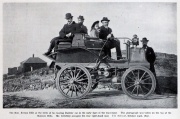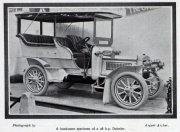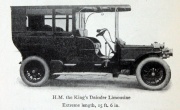Daimler: Cars


















Note: This is a sub-section of Daimler
1896 Frederick Simms and Harry Lawson moved into car production in the city of Coventry as the "Daimler Motor Company". On January 14th the company was registered and imported vehicles until the Coventry factory could start production. Frederick Simms was appointed consulting engineer with James S. Critchley as Works Manager.[1]
1896. Daimler of 40 Holborn Viaduct, London, and of Coventry showed several cars at the 1896 Motor Show. [2]
1896. Issued their first catalogue but only listed Panhard and Peugeot cars and nothing made in Coventry.
1897. At the 1897 Stanley Cycle Show they exhibited the Marseilles phaeton which had the novelty of a hood.
1897 Summer. The first car purchased by anyone unconnected with the motor trade when a car was delivered to Major Montgomery of Winchester.
1897. July. Evelyn Ellis and J. S. Critchley take a car to the top of Malvern beacon.
1897 October. Henry Sturmey and mechanic ? Ashley set off from John o'Groats to Land's End on 2nd October and completed the 939 miles in 93.5 hours. The car was a 4 h.p. Daimler.
1898. The premises were known as the 'Motor Mills' and housed in addition to Daimler, the Great Horseless Carriage Co, the Beeston Pneumatic Tyre Co., the Humber Cycle Company and the British Motor Syndicate.[3]
1898. March. Issued a catalogue showing products actually made by the company. All models used the same 4 h.p. engine but with different bodies named Rougemont, Siamese, Wyley, Grafton, Universal and the Jaunting car.
1898. Built a four-cylinder 8 h.p. engine and the first of these was sold to Boverton Redwood - possibly the first four-cylinder car made in the UK.
1899 February. Article on a new model.[4]
1899. Took part in trials at the 1899 Motor Show (Richmond) and were awarded gold medals
1899. A 6 h.p. Daimler car owned by the company turned over in the Harrow Road (Grove Hill), London and killed the driver named Edwin Sewell and a James Richer. Damages of £655 were awarded against the company.
1900. The licence granted to the Daimler Motor Company included the right to use the Daimler name in Great Britain. Gottlieb Daimler died in 1900, having sold licences to use the Daimler name in a number of countries. Emil Jellinek had legal problems selling German Daimlers in France and put it to Daimler Germany that he would put in a large order if they would make a car to order for him bearing his daughter's name. These cars proved enormously popular. Daimler Germany now realised the problem of having sold licences to use the Daimler name, and to avoid any further confusion and licensing troubles, the name Mercedes was adopted for all the cars built by Daimler Motoren Gesellschaft itself, in 1902, while the name Daimler was last used for a German built car in 1908.
1900. Description of the car in the AA 1,000 mile trial in 'The Engineer'. [5]
1900. Illustration and article on the '1900 Pattern' car. [6]
1900. Paris Exhibition. Showed its 'well-known' vehicles. [7]
1901 March. Details of the new 20-hp car.[8]
1901. November. New 22 h.p. model made its first appearance.
1902 January. Details of the 22-hp light car.[9]
1902 March. Details of Oliver Stanton's 'Le Chat Noir' 24-hp car.[10]
1902 July. Detailed review of their cars.[11][12]
1904 March. Details of their cars.[13]
1904. Company making 7, 16-20, 18-22, 28-36 h.p. models with the last two available in two types.
1904 July. Details of the 28-hp car.[14][15]
1905 February. Details of their 1905 models - 28-36 hp.[16][17][18]
1905 November. Details of their 28hp, 30hp and 35hp cars.[19]
1905. Produced 28-36 h.p., 30-40 h.p. and 35-45 h.p models. [20]
1906. See Daimler: 1906 Some Purchasers
1906 June. Details of the 45-hp car.[21]
1907 November. Details of their new 1908 models including 30-hp and 42-hp models.[22][23]
1907. The fluted radiator grille has been the Daimler marque's distinguishing feature. The company acquired a Knight Engine licence in 1908 to build sleeve valve engines for its automobiles.
1908 September. Details of their new engine.[24][25]
1908 October. Article on the Silent Knight engine by C. Y. Knight.[26]
1908 November. Details of the 15-hp, 15-20-hp, 38-hp, 57-hp cars shown at Olympia.[27]
1908 November. Detail criticism of the new Daimler engine by the Royal Automobile Club.[28]
1909 February. Report on a week with the 38-hp car.[29]
1909 October. Details of the cars. 15-hp 22-hp, 33-hp, 38-hp and 57-hp.[30]
1910 September. Details of the new 12-hp car for 1911.[31]
1911 October. The range for 1912 is seven models: 15hp (4); 23hp (6); two new models with the 90 x 130 engine; 20hp (4); 38hp (6); and the 38hp (4).[32]
1911. Smithfield Club Show. Exhibited a 36 hp general purpose machine. [33]
1912 October. Details of the 15hp (4), 23hp (6), 26hp (replaces the 25hp), 30hp (6), 38hp (4).[34]
1912 November. Details of the new 38hp six-cylinder car.[35]
1913 March. Details of the seven-jet carburettor.[36]
1913-1917. For a list of the models and prices of Cars see the 1917 Red Book
1913-1917. For a list of the models and prices of Petrol Motors see the 1917 Red Book
1913. April. Advert in Autocar. Testimonial to 50,000 trouble free miles. [37]
1913 October. Details of the four models for next year: 20-hp (4), 30-hp (4), 30-hp (6), and 45-hp (6).[38]
1914. Manufacturers of motor cars. Specialities: motors, motor cars, commercial vehicles, road trains, etc. Employees 5,000. [39]
1914. In addition to cars, Daimler produced engines for the very first tanks ever built in 1914 ("Little Willie" and "Big Willie"), a scout army vehicle, engines used in aeroplanes, ambulances, trucks, and double-decker buses. In late 1920s, it, together with AEC, formed the Associated Daimler Co to build commercial vehicles.
1914 October. Details of the three models: Special 100 x 130mm six-cylinder; 90 x 130mm six-cylinder; 90 x 130mm four-cylinder. All Knight sleeve-valve.[40]
1919. Produced 'Light' and 'Standard' versions of the 30-hp and a 'Special' 45-hp model.
1920. October. Exhibited at the Commercial Motor Exhibition at Olympia with with a tipping lorry of 2 tons. [41]
1920. November. Exhibited at the Motor Car Show at Olympia and the White City with 30 and 45 hp cars. Four-speed gearboxes and worm final drive are used. [42]
1923. Launched the 12 h.p. six-cylinder car.
1924. Introduced the new 35 h.p. model with brakes on all four wheels
1926. Introduced a twelve-cylinder engined car of 7,136cc.
1927. A smaller 'double-six' of 3,744cc was introduced
1930/1 Daimler, through BSA, took over Lanchester Motor Co, which had the distinction of having been the maker of Britain's first production car.
WWII During World War II, Daimler production was geared to military vehicles. After that war, Daimler produced the Ferret armoured car, a military reconnaissance vehicle, which has been used by over 36 countries.
c.1939 Barker and Co (Coachbuilders), and Hooper and Co became part of the Daimler Group
Daimler was a proponent of the pre-selector gearbox. This was used in passenger vehicles and military vehicles.
1951 Jack Sangster had sold Ariel and Triumph to BSA, and joined their board. The Docker Daimler era was soon to end.
1951 Exhibitor at the 1951 Motor Show in the Car Section.
1952 The first was the "Golden Daimler", an opulent touring limousine, in 1952, "Blue Clover, a two door sportsman's coupe.
1953 The "Silver Flash" based on the 3 litre Regency chassis.
1954 "Stardust", redolent of the "Gold Car", but based on the DK400 chassis.
1956 Sangster was voted in as the new Chairman, defeating Sir Bernard 6 to 3, and he promptly made Edward Turner head of the automotive division. This then included Ariel, Triumph, and BSA motorcycles, as well as Daimler and Carbodies (London Taxicab manufacturers). Turner then designed the Daimler SP250 and Majestic Major, with lightweight hemi head Daimler 2.5 & 4.5 Litre V8 Engines. Under Sangster Daimler's vehicles became a little more performance oriented.
Daimler struggled after the War, producing too many models with short runs and limited production, and frequently selling too few of each model, while Jaguar seemed to know what the public wanted and expanded rapidly.
1963 Motor Show exhibitor. Showed 2.5 Litre V8 Saloon, 4.5 Litre Majestic Major, 8-Seater Limousine and 2.5 Litre SP250 Sports Car. [43]
2006 Production is limited to only one model, the Daimler Super Eight.
Early Registrations
- 1899 DU 630
- 1909 H 6779
- 1920 A 1097
List of Models
- Daimler: 4 h.p. c1899
- Daimler: 6 h.p. c1899
- Daimler: 8 h.p. c1899
- Daimler: 12 h.p. c1899
- Daimler: 22 h.p. 1901
- Daimler: 7 h.p. 1904
- Daimler: 16-20 h.p. 1904
- Daimler: 18-22 h.p. 1904
- Daimler: 28-36 h.p. 1904
- Daimler: 28-36 h.p. 1905
- Daimler: 30-40 h.p. 1905
- Daimler: 35-45 h.p. 1905
- Daimler: 2.5-Litre Dauphin
- Daimler: 2.5-Litre Special Sports
- Daimler: 2.5-Litre Consort Salon
- Daimler: Straight Eight 1936-53
- Daimler: V8 250 1962-69 - (17,620 produced)
- Daimler: DB18 1938-50 - (3,355 produced) - 2.5 Litre
- Daimler: Consort 1949-53 - (4,250 produced)
- Daimler: DE27 1946-51 - (255 produced)
- Daimler: DE36 Straight Eight 1946-53 - (205 produced)
- Daimler: Regency 1951-56 - (453 produced)
- Daimler: Conquest 1953-56 - (9,739 produced) - Conquest, Century and Roadster
- Daimler: Century
- Daimler: Regina 1954-60 - (132 produced) Including DK400
- Daimler: 104 1955-59 (561 produced)
- Majestic 1958-62 - (1,490 produced)
- Daimler: Majestic Major 1960-68 - (1,180 produced)
- Daimler: DR450 1961-68 - (864 produced)
- Daimler: SP250 Dart 1959-64 - (2,650 produced)
- Daimler: Sovereign 1966-69 - (5,700 produced)
- DS420 Limousine 1968-92
- Sovereign (XJ6-type S1 and S11 1969-79
- Double Six S1 and S11 1972-79
- Sovereign Coupe/Double Six Coupe 1975-77
- Sovereign S111 1979-87
- Double Six S111 1979-92
See Also
Sources of Information
- ↑ Vital to the Life of the Nation. Published 1946.
- ↑ Vital to the Life of the Nation. Published 1946.
- ↑ Vital to the Life of the Nation. Published 1946.
- ↑ The Autocar 1899/02/04
- ↑ The Engineer of 27th April 1900 p428
- ↑ The Engineer of 15th June 1900 p625
- ↑ The Engineer of 14th September 1900 p253
- ↑ The Autocar 1901/03/16
- ↑ The Autocar 1902/01/25
- ↑ The Autocar 1902/03/01
- ↑ Automotor Journal 1902/07/26
- ↑ Automotor Journal 1902/08/02
- ↑ Automotor Journal 1904/03/05
- ↑ The Autocar 1904/07/23
- ↑ The Autocar 1904/08/13
- ↑ Automotor Journal 1905/02/11
- ↑ Automotor Journal 1905/02/18
- ↑ Automotor Journal 1905/02/25
- ↑ Automotor Journal 1905/11/18
- ↑ The Automobile Vol. III. Edited by Paul N. Hasluck and published by Cassell and Co in 1906
- ↑ The Autocar 1906/06/02
- ↑ Automotor Journal 1907/11/09
- ↑ Automotor Journal 1907/11/16
- ↑ Automotor Journal 1908/09/19
- ↑ The Autocar 1908/09/19
- ↑ Automotor Journal 1908/10/24
- ↑ Automotor Journal 1908/11/14
- ↑ The Autocar 1908/10/31
- ↑ Automotor Journal 1909/02/20
- ↑ The Autocar 1909/10/30
- ↑ The Autocar 1910/09/24
- ↑ The Autocar 1911/10/14
- ↑ The Engineer 1911/12/08 1911 p594
- ↑ The Autocar 1912/10/19
- ↑ The Autocar 1912/11/09
- ↑ The Autocar 1913/03/08
- ↑ The Autocar of 5th April 1913
- ↑ The Autocar 1913/10/04
- ↑ 1914 Whitakers Red Book
- ↑ The Autocar 1914/07/07
- ↑ The Engineer of 22nd October 1920 p400
- ↑ The Engineer of 19th November 1920 p498
- ↑ 1963 Motor Show
- Wikipedia
- Ian Allan - British Buses Since 1900 - Aldridge and Morris
- 1961 Guide to Key British Enterprises: Motor, Motor-Cycle and Commercial Vehicle Manufacturers
- British Motor Cars 1950/51





































































































































